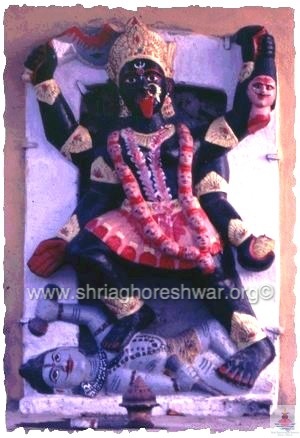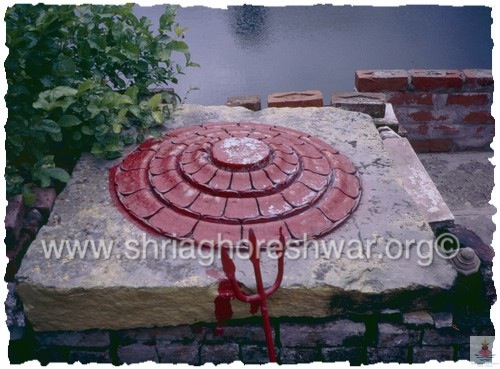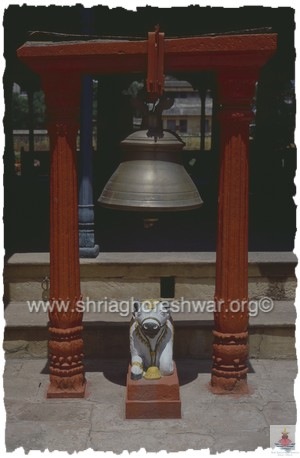Percorso

The Masters of Krin Kund

Shri Aghoreshwar – Abisheka of Baba Gautam Siddharth Ram, 1978
1 – Baba Kalu Ram
2 – Baba Kina Ram
3 – Baba Bija Ram
4 – Baba Dhantar Ram
5 – Baba Gaibi Ram
6 – Baba Bhawani Ram
7 – Baba Jayanarayan Ram
8 – Baba Mathura Ram
9 – Baba Saryu Ram
10 – Baba Dal Singar Ram
11 – Baba Rajeshwar Ram
12 – Baba Gautam Siddharth Ram
Baba Kina Ram appeared as a bright star, leaving a powerful line of disciples behind him. For three centuries Kinarami saints, in northern India and in other foreign nations, have been able to inspire human service and give spiritual prosperity. Establishing more places around Varanasi, Baba Kinaram has probably accepted the challenge to protect this city.

Kali Ma at Baba Kina Ram Sthal
Before entering into the study of the tradition of the disciples of Aughar places, we have to tell that inside this line of disciples two important Priors or mahants, Baba Bija Ram and Baba Ramjivan Ram, came from the so to speak “Low caste” of sellers of liquors. The priors of this places could indistinctly come from each of four main Hindu castes. With this revolutionary point of view, in the area where He gave his services, He raised Hindu society’s spirit and saved it from decay.

Baba Bija Ram
It is necessary to know that Baba united solidly all the Hindus, harmonizing the three main religious currents of Hinduism wonderfully – Shivaism, Shaktism and Vishnuism.
To keep from publicizing themselves, these saints haven’t left any autobiography, nor their disciples and followers did it. That’s why telling life of Baba Kina Ram’s disciples is a very difficult task. It has been possible to know something only about castes and names of those great men who were priors and Aghoracharya of Ramgarh and Krind Kund Shivala of Varanasi. Another noteworthy thing is that the main Acharya-mahants took the four Aghor sthals upon themselves at the same time. One of them, Baba Hubba Ram, prior or mahant of Ramgarh-sthal, attended to manage all four sthals simultaneously.

The gate of Krin Kund, 1989
In the tradition of Kinarami Babas’ disciples there are two kinds of practitioners. The first are mahants or Acharyas who were the ones in charge of a sthal. These great men, living on charity, fortified religious sentiments of their disciples. In Ramgarh, Deval and Hariharpur there were some goods, such as elephants, horses and further riches, devotees had given, but this wealth was used for people’s welfare.
The other disciples are called “Murya” or initiates and they used the energy they earned through their Aghor sadhana to help people. They are many and there aren’t more details about them. Living in the four sthal, some of these Murya attends to Samadhis, Sthal and Mahant and some lives in huts built in the name of Baba Kina Ram and most of them keeps travelling across the nation and abroad.

Samadhi of Baba Kina Ramji
The particularity of Baba Kina Ram’s place is that there are many tombs of mahants and of the so-called Murya practitioners, too. As we told before, worship of the saints lying in the grave is very important for Aghoris. An Aughar sadhu’s body, after his death, is placed inside a tomb and, even in this condition, this Aughar contacts, inspires and leads sincere sadhus. Beside graves, symbols of devotees’ faith, the spot or place where Aghor Mahants did their spiritual practice are kept clean, as articles of worship, and in these places a veranda is also built. In Ramgarh, in the spot where Baba Kina Ram used to pray, was built a stone temple whose columns were carved with many images. In these places service for guests and sadhus is very important.

Samadhi of Aghoris
In this tradition, beside sadhus, there are also disciples who are married. There are different categories of these married practitioners, too. We don’t know how many they are. During the age of foreign invasions many people were expelled from their castes. This Aughar tradition gave shelter to these people, too. In this tradition even the prostitutes of Kashi whom nobody wanted to accept in society became disciples and changes in their lives were enormous. Except for Hindu high castes, misfits and frightened people from other castes were protected only by this Kinarami community.
Baba Kina Ram’s famous regency or chair, Krin Kund Shivala, is in Varanasi.

Samadhi
Baba Bija Ram came from a noble but poor family. He was born in the village of Naidih in Ghazipur provincial district. Except for hints about Baba Kina Ram’s life he did, with whom he lived during his travel across Girnar, when Baba Kina Ram met Baba Kalu Ram, for readers there aren’t further information. Faith and devotion for his Guru is a thing it has been talked about very well. As good disciple of a competent Guru, he played a very important role in spreading Aghor practice. In portrayals of Baba Kina Ram, He was described as a man who was willing to serve his Guru with fervor.

Yantra at Krin Kund
Baba Dhantar Ram became Mahant after Baba Bija Ram. He came from Brahmin caste. His great merit was to attend to the sthal after an Acharya coming from the caste of sellers of liquors. With his help, he too contributed to keeping this tradition alive and to promoting its development.
Baba Gaibi Ram, or Gauri Ram, attended to regency after Baba Dhantar Ram. In Varanasi, close to Kamaksha, there is a famous well called “Gaibi’s well”. It is a very beautiful place, right for sadhana. Its water is miraculous and people from Varanasi even take it home. In this water there is the effect of Baba’s miraculous power, which gives to this water a famous curative property to remove kidney stones. It is said that he was a state employee before and that he came from Brahmin caste. Once, when he was blamed for drinking alcohol and expelled from his caste, he went to the ashram. This Baba had a wonderful organizational ability. While he was in charge, he ordered a wall enclosure around Krin Kund Kina Ram Sthal to be built.

Samadhis of Aghoris at Baba Kina Ram Sthal
Baba Bhawani Ram came from Kshatriya caste. Famous sadhaks remember his name with much respect, but there aren’t many details about him.
Baba Bhawani Ram’s famous successor was Baba Jayanarayan Ram. His current name is mentioned as “Dinaraya Ram” and he came from the caste of sellers of liquors.

The bell
Not far from the village of Balua, near Varanasi, the course of the Ganges bifurcates and western fork is a very holy area. In February and just when the black moon called ‘Mauni’ appeared in the sky, there was a big feast centered around the general holy bath in the river. In this village Baba Jaynarayan Ram was born into Jaiswal Kalwar famous family. We don’t know exactly his date of birth, but we know that in 1857, during the independence war, he was already a big boy. Traditionally his family dealt with cane sugar trade. His family was rich and we can see that even today for the Shiva temple their ancestors built in that village. Ups and downs of business are a regular thing, so when the members of his family had a crash, they moved to Adalpur in Mirzapur provincial district. There, He was dissatisfied and suddenly, because of the call of his native land, he went back to Baba Kinaram sthal in Varanasi. In that period Baba Bhawani, a very detached and open person, was the mahant of the sthal. He used to lie down on Guru’s place and every two or three days he left the sthal and went from door to door humbly looking for a little bit of all kinds of food and came back satisfied. Visitors too were free to go away after imploring Him. Baba Janarayan Ram was very lucky to have found a Guru like Baba Bhawani Ram, a self-satisfied practitioner. At that moment running of the ashram also was good. He asked his just initiated disciple to live in the village of Khojawani Bazar, very far from the ashram. In the beginning people of that village were hostile, but within a few days the whole village became devotee of him, because of his life spent in praying in privation and of his love. In this place Baba built a hermitage and a well still there. His ashram started receiving means of subsistence from the bazaar regularly and even today these means are available for the Kinaram Sthal in Varanasi.

Samadhi of Baba Kina Ramji
While in Khojawani, Baba spent a lot of time serving his Guru. In that period Baba Bhawani Ram tried him and when he got angry with Him, he beat this disciple very hard with a piece of wood taken from a funeral pile. Baba Jaynarayan Ram used to say that devotion to the Guru is like running on a knife’s edge, that is very difficult. Nevertheless he succeed in passing the trials he had to undergo. Taking him under his tutelage, Baba Bhawani Ram nominated him as his successor. Baba Jaynarayan Ram attended to the sthal after Baba Bhawani Ram’s death. Strangely while making the tomb of his Guru, He ordered his own tomb to be built. He used to say that it was made so that death could be an ever present memento. He lived only on charity. Whatever offerings might have come, they were always used for bettering the ashram that in that period made satisfactory progress.

Krin Kund
This Baba was an excellent expert on Ashtanga yoga. Nobody ever saw him sleeping and besides he ate very little. He had very high-level spiritual powers. Although he was in the ashram, He could met his devotees in Calcutta, in Ganga Sagar and in other places all the same. Sometimes it happened that even five or ten people together weren’t able to shift or raise the chair He was sitting on and sometimes, when he was in good mood, even one weak person could do it. He never revealed his spiritual faculties. If somebody came to him with some wishes to be fulfilled, He said: “Go and pray at the tomb of Baba Kalu Ram and Baba Kina Ram, only they can do what they want.” And then He added: “It is He who carries out anything.”

Baba Kina Ramji’s Chauki
He never wanted wealth and possessions. The members of his family were in Varanasi, but he never kept in touch with them. Although in Aghor tradition there were no restriction as regards alcohol, He always told his disciples the following words: “The inebriation of the prayer, you will never find it in those things that inebriate you.”
In the ashram he started the tradition of two festivals, one on the twelfth day of Ramnavami and the other on Lolark Chhath in August. On both the occasions, all the girls from Varanasi, even prostitutes, performed dances and chants for the ashram. The observance of these feasts is still in force but in 1958 prostitutes’ dances were forbidden because of the incidents reactionary students provoked.

Old Samadhis in the garden
He wasn’t a Master who liked to increase the number of his disciples because according to his own words: “Guru, as well as parents who have a responsibility to bring their children up, have a same responsibility towards his disciples.” If somebody tried bribing him with money, He answered abruptly saying: “Guru Mantra isn’t a thing for sale.”
He also had Vaishnav disciples, such as Shri Ramdas, Mishra Katthak, Bari Moti Bai. His disciples Sumeru and Bhairav Ram were very dear to Baba. He had a good knowledge of music and listening to his sitar and his tambourine was a happy experience even for great artists. He was so popular that, when he was still alive, his image was worshipped in hundreds of houses. He took his Samadhi (that is, He died) on May 4th , 1923 when he was around one hundred years old.

Kapal
After his death, Baba Mathura Ram, from the caste of potters, became mahant. We don’t know much about him from his date of birth onwards and his disciple Baba Saryu Ram, from Brahmin caste, became mahant after him. What we know is that He was born in a village in Jaunpur provincial district. Even today his descendants are wandering Aughars.
Baba Dal Singar Ram was born into a high-ranking Kshatrya family from Varanasi. After being initiated, He stayed in his hermitage in an unspecified spot on the bank of the Ganges and He remained there, engaged in his sadhana. Through his sadhana, He obtained a very high spiritual status. He became mahant of Kinaram sthal in Varanasi and, by living in Guru’s place, he made considerable progress.

Samadhi of Baba Rajeshwar Ramji, Krin Kund
Baba Rajeshwar Ramji was mahant of Kinaram sthal in Varanasi after Baba Dal Singar Ram. He was born into an important Kshatrya family from Varanasi. After having been married, by mutual consent with his wife, he dissolved his marriage and the young Rajeshwar Ram started travelling in search of a spiritual path. After visiting several places and followed different masters in Bihar, Bengal, Bhutan and Sikkim, he came back to Varanasi, to Krin Kund, where he was initiated into Aghor practice by Baba Mathura Ram. His character, like that of a child, was so simple that he gave great respect and much love even to most common people. Many of his prodigious spiritual faculties have been assimilated by his disciples. Baba Rajeshwar Ram’s excellent reputation is proved by his glorious disciple Aughar Bhagwan Ram.
Beside the Samadhis of the Sthal Mahants, there are those of Aghori sadhus who have been living or have been initiated there.

Baba Kina Ramji
Aghoris of Kina Ram Sthal, Kashi:
1. Avataru Ram
2. Somaru Ram
3. Mangaru Ram
4. Santu Ram
5. Kedar Ram
6. Saryu Ram
7. Gauramai Ram
8. Jhulai Ram
9. Gulab Ram
10. Gopal Ram
11. Janaki Ram
12. Ayodhya Ram
13. Mulaki Ram
14. Puran Ram
16. Domodan Ram
17. Vishwanath Ram
18. Bhairon Ram
19. Somaru Ram
20. Paltan Ram alias Naga Baba
21. Sita Ram
22. Sirtan Ram
23. Raghunandan Ram
24. Badul Ram
25. Kauleshwar Ram
26. Adalat Ram
27. Bhairon Ram
28. Rajjù Ram
29. Khelari Ram
30. Bali Ram
31. Mangru Ram
32. Bawan Ram
33. Bala Ram
34. Dobha Ram
35. Tamasa Ram



